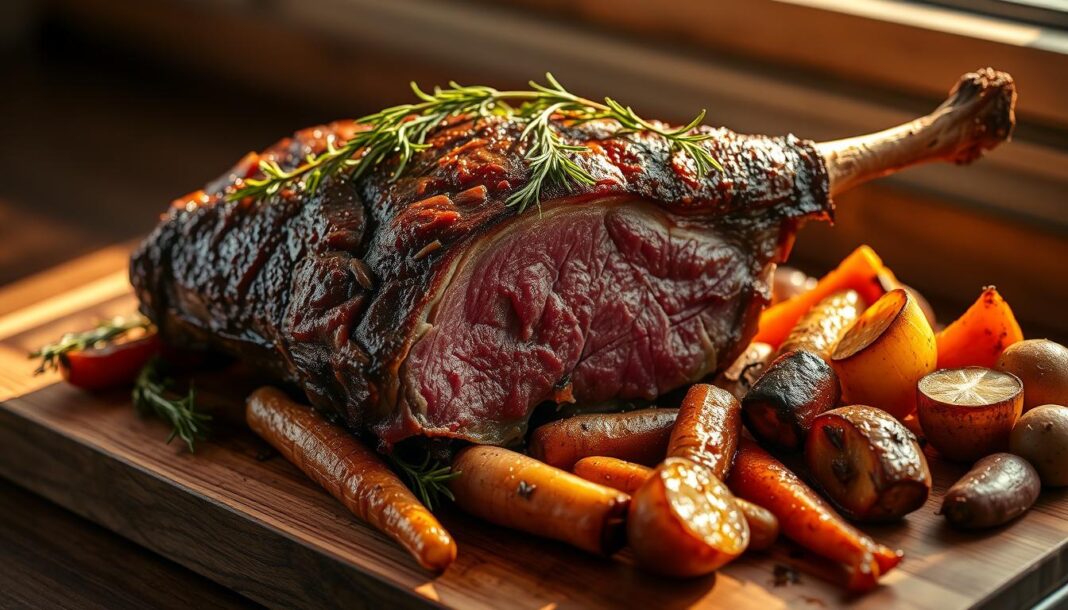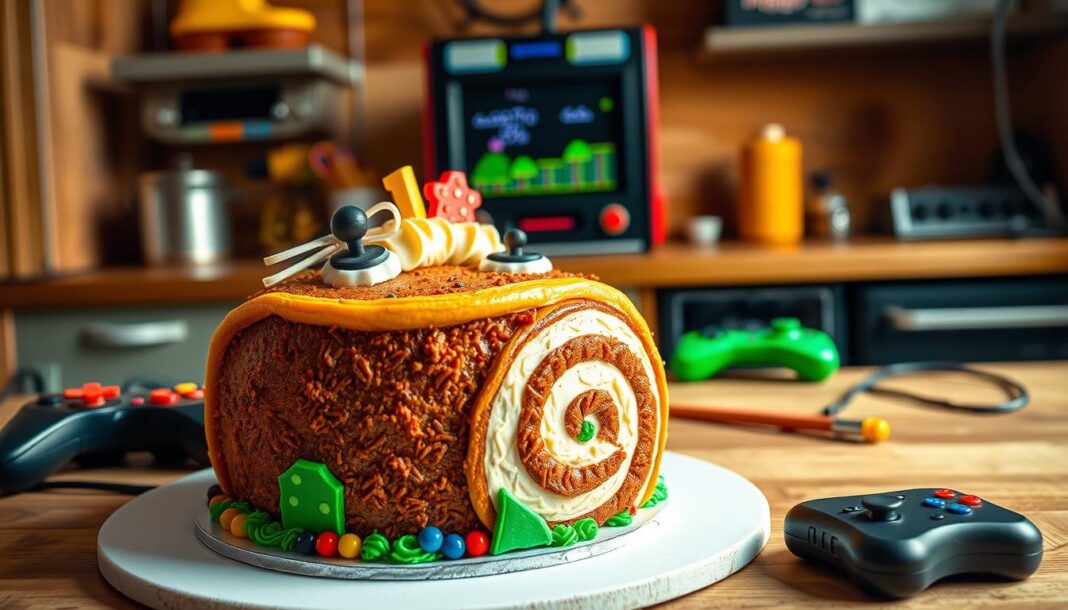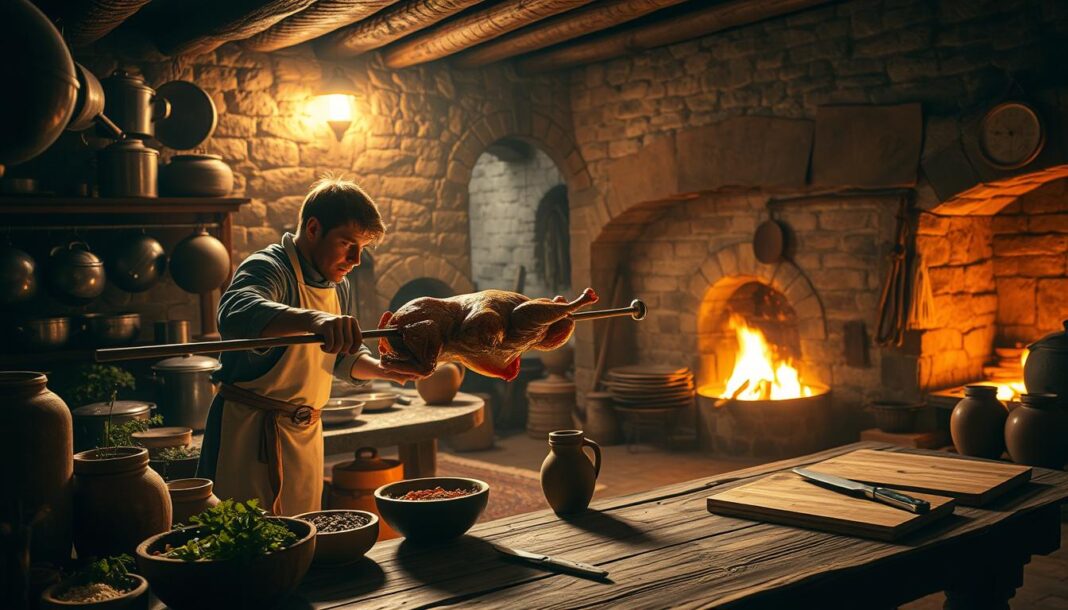Cooking venison to perfection is an art that requires understanding its unique characteristics. As we explore the historical significance of this distinctive game meat, we’ll uncover why it remains a prized ingredient in modern cuisine. Unlike other types of meat, venison’s lean properties demand specific cooking techniques to achieve tender results.
Traditionally, roasting venison in the oven has been a preferred method, allowing for even heat distribution and retention of flavors. For a successful roast, it’s essential to follow tried-and-true methods, such as those detailed in historical cooking guides, like roasting a haunch of venison. By mastering these techniques, home cooks can achieve restaurant-quality dishes.
Key Takeaways
- Understanding venison’s unique characteristics is crucial for perfect cooking.
- Historical cooking methods provide valuable insights into roasting venison.
- Mastering oven roasting techniques ensures tender and flavorful results.
- Venison’s lean properties require specific cooking approaches.
- Traditional roasting remains a preferred method for cooking venison.
The Rich Heritage of Venison Cuisine
The culinary history of venison is as rich as it is complex, spanning thousands of years and crossing multiple continents. Venison, the meat of deer, has been a staple in many cultures, valued for its lean protein and distinctive flavor.
Venison Through the Ages
Historically, venison was a crucial source of nutrition, particularly in times when other meat sources were scarce. The low fat content in venison made it a prized food, especially during periods of scarcity. As civilizations evolved, so did the methods of preparing venison, reflecting the culinary traditions of various cultures.
Why Venison Remains a Prized Meat Today
Today, venison remains sought after for its nutritional profile and unique taste. Being significantly leaner than beef, venison cooks faster due to its lower fat content, which acts as an insulator in fattier meats. This characteristic makes venison an attractive option for health-conscious diners. The table below highlights the key differences between venison and beef.
| Characteristics | Venison | Beef |
|---|---|---|
| Fat Content | Low | Variable, often higher |
| Cooking Time | Faster (~2/3 of beef) | Longer |
| Protein Content | High | High |

Understanding Venison: What Makes It Unique
Venison, a meat with a rich history, offers a unique culinary experience due to its distinct nutritional profile and flavor characteristics. We will explore what makes venison stand out by examining its nutritional content and comparing it to other meats.
Nutritional Profile of Venison
Venison is renowned for its high protein and low fat content, making it an attractive option for those seeking a healthier red meat alternative. A serving of venison contains approximately 26g of protein and only 15g of fat, with a calorie count of 268 per serving. It is also rich in essential minerals such as iron (23% daily value) and potassium (6% daily value). With minimal carbohydrates (8g) and 1g of fiber, venison is a nutrient-dense choice.
Comparing Venison to Beef and Other Meats
When compared to beef, venison’s leaner composition becomes apparent. Venison contains less fat than many types of beef, making it a preferable choice for those monitoring their fat intake. The cooking properties of venison also differ due to its lean nature, requiring adjusted cooking techniques to achieve optimal tenderness. Additionally, the diet of wild versus farm-raised deer can affect the flavor profile and nutritional composition of venison, offering varied culinary experiences.
Preparing Venison for the Oven
Before you put venison in the oven, there are several steps you should take to ensure it turns out tender and flavorful. Proper preparation is key to a delicious venison dish.
Selecting the Right Cut
Choosing the right cut of venison is crucial for oven cooking. Different parts of the deer, such as the loin, shoulder, and haunch, respond differently to heat. Understanding the age and origin of your meat is also important, as these factors significantly impact tenderness and cooking requirements.
Trimming and Preparing the Meat
Properly trimming venison involves removing silverskin and excess fat, which can contribute to gamey flavors. Patting the meat dry with paper towels before cooking helps it brown better. Bringing venison to room temperature before cooking ensures even cooking.
Marinades and Rubs for Venison
Effective marinades tenderize the meat while adding flavor. For a coffee rub, combine 1 tablespoon kosher salt, 1 teaspoon freshly ground pepper, 2 teaspoons ancho chile powder, 1 teaspoon ground coriander, 1 teaspoon ground cumin, 1 tablespoon brown sugar, and 1 tablespoon powdered espresso. Rub the mixture onto your venison steaks or roast, then drizzle with a bit of oil to enhance flavor.
| Preparation Step | Purpose | Tips |
|---|---|---|
| Selecting the Right Cut | Ensures tenderness and flavor | Consider the age and origin of the venison |
| Trimming and Preparing | Removes excess fat and silverskin | Pat dry with paper towels before cooking |
| Marinades and Rubs | Tenderizes and adds flavor | Use acidic components and flavorful spices |
Cooking Venison in the Oven: Essential Techniques
To achieve perfectly cooked venison, understanding the nuances of oven cooking is essential. The oven provides a controlled environment that allows for precise temperature control, which is crucial for cooking venison to the desired level of doneness.
The Inverse-Oven Method for Perfect Doneness
The inverse-oven technique involves starting the venison in a low-temperature oven (300°F) until it reaches a few degrees below the desired finished temperature, then finishing it in a very hot skillet to sear the outside. For medium-rare venison loin, cook until the center registers 120°F on an instant-read thermometer. This method ensures perfectly evenly cooked meat.
Low and Slow Roasting for Tender Results
Low and slow roasting is another effective method for cooking venison, particularly for tougher cuts. By cooking the venison at a low temperature for an extended period, the connective tissues break down, resulting in tender and flavorful meat. This technique is ideal for larger cuts of venison.
Temperature Guidelines for Different Cuts
Different cuts of venison require different internal temperatures to achieve optimal doneness. For most cuts, medium-rare is ideal, with an internal temperature of 135°F. Using a meat thermometer is crucial for achieving consistent results.
| Venison Cut | Recommended Internal Temperature | Cooking Time |
|---|---|---|
| Venison Loin | 120°F – 130°F | 15-20 minutes |
| Venison Roast | 135°F – 140°F | 1-2 hours |
| Venison Steaks | 120°F – 135°F | 8-12 minutes |
By applying these techniques and guidelines, home cooks can achieve perfectly cooked venison with ease. Whether using the inverse-oven method or low and slow roasting, the key to success lies in precise temperature control and attention to cooking time.
Best Recipes for Venison in the Oven
For those looking to elevate their venison cooking skills, we’ve compiled three exceptional oven-based recipes that showcase the versatility and flavor of this prized meat.
Venison Roast with Rich Gravy
Our venison roast recipe features a tender and flavorful dish, seasoned with garlic, grill seasoning, and chili powder, then slow-cooked in beef broth. To make, season 1 pound boneless venison roast with 1 tablespoon minced garlic, 1 tablespoon grill seasoning, and 1 teaspoon chili powder. Place in a casserole dish with 2 cups beef broth, cover, and bake at 350°F for about 1 hour until tender. For the rich gravy, melt ¼ cup butter, whisk in ¼ cup flour until golden, then add 1½ cups of the cooking broth and simmer for 15 minutes.

Coffee-Rubbed Venison Loin
The coffee-rubbed venison loin is a unique and flavorful recipe that combines the richness of venison with the deep flavors of espresso powder. This dish is perfect for those looking to add a twist to traditional venison recipes.
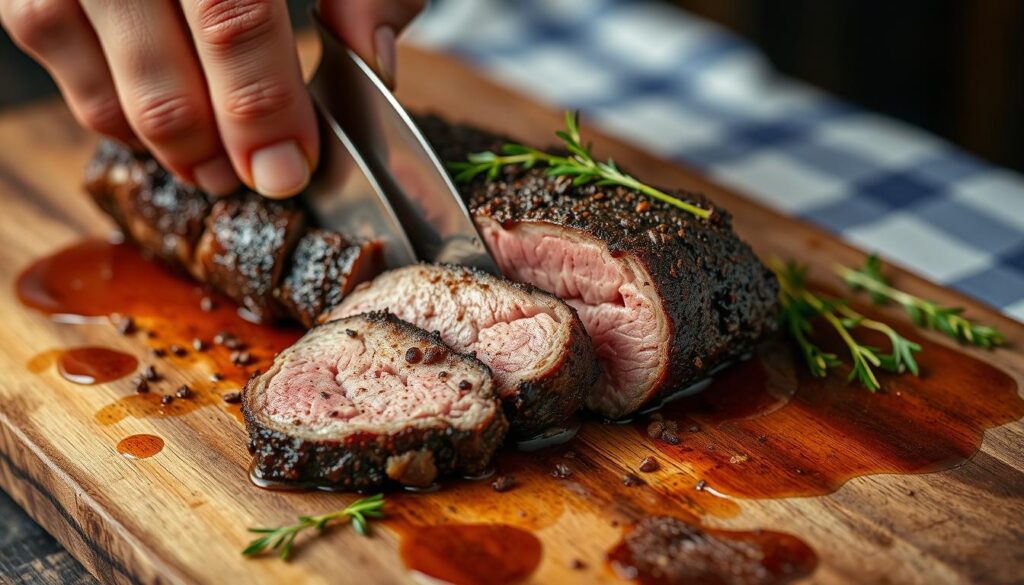
Slow-Cooked Venison with Root Vegetables
For a hearty and comforting dish, our slow-cooked venison with root vegetables is an ideal choice. This recipe utilizes a Dutch oven to tenderize the venison and blend the flavors with the vegetables.
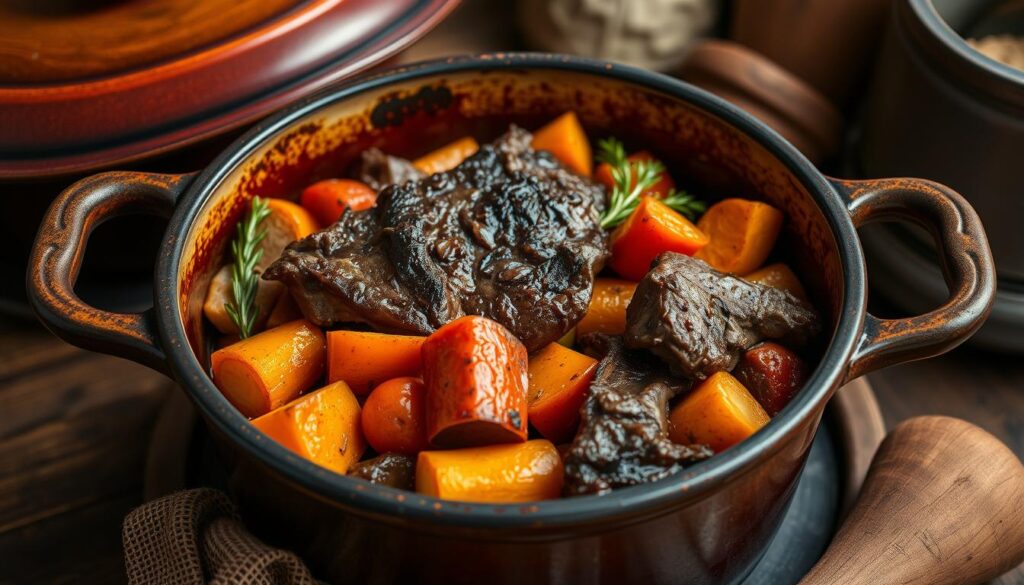
Troubleshooting Common Venison Cooking Issues
Venison, with its lean profile, requires careful cooking to prevent dryness and toughness, common issues many cooks face. When cooking venison, it’s crucial to maintain moisture and tenderness.
Preventing Dryness and Toughness
To prevent dryness, we recommend cooking venison low and slow with plenty of moisture. This method helps to keep the meat tender and juicy. After cooking, it’s essential to let the venison rest before slicing, allowing the juices to redistribute. Tenting with foil during this period helps retain heat. Additionally, incorporating butter or other fats during cooking can enhance flavor and texture.
Addressing Gamey Flavors with Juniper and Other Seasonings
Gamey flavors in venison can be addressed with the right seasonings. Juniper berries are particularly effective, as they add a delicate tartness and freshness that counteracts the gaminess. To season venison effectively, we suggest combining juniper berries with other complementary herbs and spices. This approach not only reduces undesirable flavors but also enhances the overall taste of the venison roast.
Serving Your Oven-Roasted Venison
As we conclude our comprehensive guide on cooking venison in the oven, let’s explore the final steps to make your dining experience truly exceptional. Serving your oven-roasted venison roast involves more than just placing it on a plate; it’s about creating a memorable presentation that complements its rich flavor.
To start, consider pairing your venison roast with pan-roasted vegetables like carrots and potatoes for a complete meal. A typical serving of venison contains approximately 268 calories with 1g of fiber, making it a nutritious option for various dietary approaches.
For leftovers, you can reheat your venison roast by transferring it to a baking dish, covering it loosely with foil, and reheating it in a 350°F oven for 12-15 minutes. This method helps maintain the quality and tenderness of the roast. You can also store leftovers in an airtight container in the refrigerator for 3-4 days or freeze them for up to 6 months.
